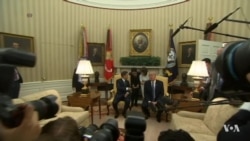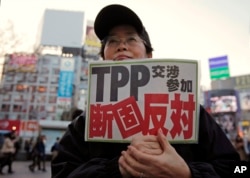It was one of Donald Trump’s very first actions as president: pulling the United States out of the Trans-Pacific Partnership, or TPP, a free-trade deal he said was hurting the American worker.
The TPP was one of the centerpieces of former President Barack Obama’s so-called Asia “pivot,” an economic, political and military realignment toward a region seen as key to America’s future.
Nine months into his presidency, Trump’s decision to abandon the TPP remains perhaps the clearest evidence yet he intends to ditch the Asia pivot, or perhaps pivot there in his own way.
U.S. officials have not said whether they will unveil a similar, definitive policy to replace the pivot. But signs of a broader strategy could emerge next week when Trump leaves on his first trip to Asia as president.
WATCH: Asia Awaits Trump's Regional Policy
Trump skipping regional summit
The trip will include stops in Japan, South Korea, China, Vietnam and the Philippines. But it’s where Trump has chosen not to go that has attracted the headlines.
Though Trump is attending the ASEAN multilateral summit in the Philippines, reports have suggested he will head home a day before the annual East Asia Summit, a regional meeting that focuses on Southeast Asia.
The move risks sending the message that Southeast Asia is not a priority for Trump, said Abraham Denmark, a former top East Asia official at the Pentagon.
“The region will see that China is there, and the United States isn’t. And that will send a very stark message,” said Denmark, who is now at the Woodrow Wilson Center for International Scholars in Washington.
It isn’t the first time that a U.S. president has skipped the summit. Obama also stayed home in 2013 to deal with domestic budget negotiations that resulted in a government shutdown.
Then, too, the move sparked controversy.
Asian diplomats and heads of state talked about Obama’s absence in private circles for years, said Harry Kazianis, who focuses on Asia at the Center for the National Interest.
“Missing one conference doesn’t mean that America is leaving the Asia-Pacific or that China is outpacing us or anything like that. But it’s an extremely big deal, and they’re not going to forget it,” Kazianis said.
Regional influence
The move could add to concerns the U.S. is ceding regional influence to China, which intensified after Trump’s decision to pull the U.S. out of the Paris climate accord as well as the TPP.
The TPP decision in particular sent shockwaves throughout Asia and threatened to fundamentally reshape the U.S. economic relationship with the region.
“You can make positive and negative arguments for the TPP — it was not a net-jobs creator for the U.S. — but it had great strategic value for the U.S.,” Kazianis said. “It was a marker. America was going to be there no matter what. That’s lost, and the Trump administration hasn’t found a formula to replace that.”
Adding to the uncertainty, Trump has also threatened to pull out of the free-trade agreement with South Korea, a longstanding economic and diplomatic partner of Washington.
North Korea
But much of Trump’s Asia tour is expected to focus on North Korea, which has dominated the bulk of U.S. foreign policy bandwidth during his first year in office.
Trump hopes to put more pressure on China, in particular, to persuade North Korean leader Kim Jong Un to make concessions on his nuclear and missile programs.
Trump has threatened to “totally destroy” North Korea if necessary to defend the U.S. and its allies, at times matching the inflammatory rhetoric typically only seen from the North.
During Trump’s trip, Asian diplomats are likely to try to convince the U.S. leader of the need to pursue diplomacy and reduce the level of rhetoric, said Michael Fuchs, a former deputy assistant secretary of state for East Asian and Pacific Affairs.
“War with North Korea is their worst nightmare,” Fuchs said.
But Trump will have plenty of time during the 12-day trip to lay out other priorities, and that can’t come a moment too soon for many.
“What our partners in Asia are looking for is not whether the Obama policy will continue,” Denmark said. “They’re looking for what is the Trump policy, what is America’s policy now.”














